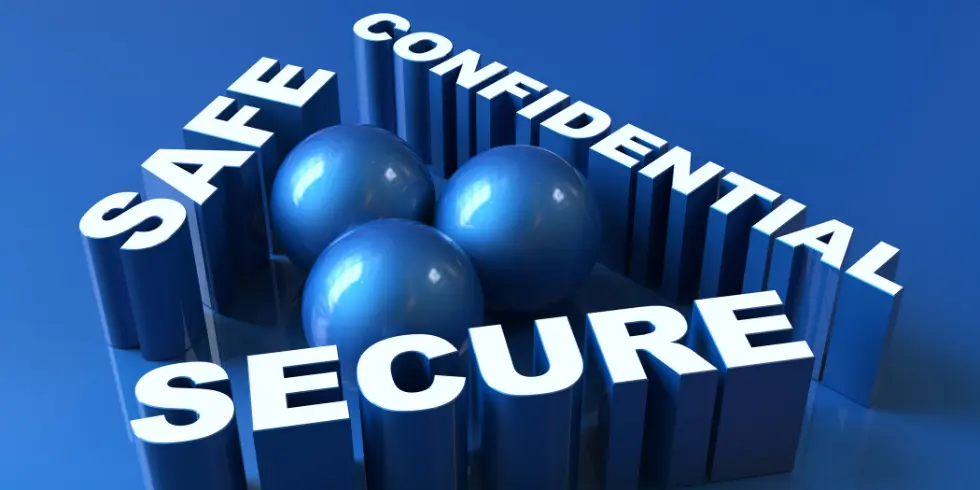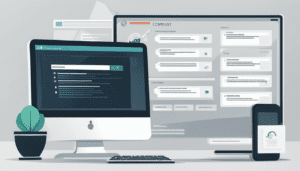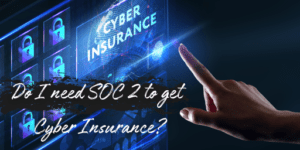As an information security professional, I know firsthand the importance of safeguarding sensitive information and preventing data breaches. This brings us to an essential subject: Introduction to SOC 2. Navigating the labyrinth of cybersecurity standards and certifications can be a daunting task for any business. If your organization handles sensitive data—be it customer information, financial records, or proprietary technology—a single misstep could spell disaster. That’s where SOC 2 comes in.
In this article, we’ll embark on a journey into the world of SOC 2 and explore its significance in ensuring information security. Join me as we delve into the requirements, benefits, and importance of SOC 2 certification. We will also delve into what SOC 2 is, the framework’s criteria for trust, the different types of SOC 2 reports, and much more. Buckle up as we demystify this complex but essential element of modern cybersecurity. For a more detailed discussion of SOC 2, please refer to this article: Your Complete Guide: Mastering SOC 2 Compliance
Key Takeaways
- SOC 2 certification indicates a high level of information security and helps defend against cyber-attacks and prevent breaches.
- SOC 2 provides a competitive advantage for service providers and is preferred by customers, especially for IT and cloud services.
- SOC 2 audits are conducted by independent CPAs or accounting firms, following professional standards set by AICPA.
- The SOC 2 security criterion checklist includes controls to prevent unauthorized use of assets and data, access controls, change management processes, and monitoring operations.
Introduction to SOC 2: What is SOC 2?
Definition and Historical Background
SOC 2 stands for “System and Organization Controls 2.” It is a framework that evaluates and reports on the effectiveness of an organization’s information security controls. This audit framework was developed by the American Institute of Certified Public Accountants (AICPA) as an extension of the Sarbanes-Oxley Act of 2002, aiming to provide a standardized benchmark for secure data management and privacy. Unlike its predecessor SOC 1, which focuses on financial reporting, SOC 2 targets security, availability, processing integrity, confidentiality, and privacy of a system’s data.
The Entities That Govern and Manage SOC 2 Standards
The AICPA is the primary body responsible for the development, governance, and management of SOC 2 standards. However, the execution and assessment of SOC 2 audits are usually carried out by certified and independent third-party auditors. These auditors review the controls and processes in place within an organization to ensure they meet the AICPA’s Trust Services Criteria.
Importance of SOC 2 in the Context of Data Security
In today’s digital world, data breaches are more common than ever, with incidents causing massive disruptions and financial losses. The repercussions can severely impact the reputation and operational efficiency of the affected organization. SOC 2 acts as a safeguard in this context, ensuring that organizations maintain rigorous data security measures. Achieving SOC 2 certification doesn’t just protect your business; it builds trust with your clients and partners. When an organization can demonstrate SOC 2 certification, it signals to stakeholders that the company takes data security seriously, thus elevating its market reputation and competitive edge.
| Framework | Scope | Audience | Benefits |
|---|---|---|---|
| SOC 2 | Focuses on the evaluation of data management by service providers based on five Trust Service Criteria: Security, Availability, Processing Integrity, Confidentiality, and Privacy. Only Security is mandatory. | Targeted at users familiar with the service provider's controls, including the service provider's management, user entities, and specified third parties. | Offers validation that the service provider maintains robust controls to safeguard partner data. Aids in fulfilling regulatory and contract compliance. |
| ISO 27001 | A comprehensive global standard for the establishment and ongoing improvement of an information security management system (ISMS), encompassing all areas such as risk assessment and policy implementation. | Applicable to any organization aiming to uphold information security best practices. Stakeholders include customers, regulatory bodies, and auditors. | Delivers a structured framework for managing information security risks and ensures continuous betterment. Enhances market competitiveness and customer trust. |
| NIST CSF | A non-mandatory set of guidelines, featuring five core functions: Identify, Protect, Detect, Respond, and Recover. Aims to align cybersecurity efforts with business goals. | Designed for organizations of all sizes looking to bolster cybersecurity. Users range from top-level executives to IT professionals. | Facilitates standardized communication about cybersecurity risks, helps identify gaps, and prioritizes areas for improvement. |
| COBIT 5 | An expansive framework offering insights into IT governance and management, founded on five key principles. Incorporates 37 processes covering all aspects of IT governance. | Target audience includes board members, executives, managers, and IT governance consultants. | Provides a unified, holistic methodology for achieving business-aligned IT objectives. Assists in compliance, IT performance optimization, and elevating stakeholder trust. |
Understanding the SOC 2 Trust Services Criteria (TSP)
Understanding the Five Trust Service Criteria is pivotal for comprehending the depth and breadth of SOC 2’s impact on data security. These criteria set the standard for how service organizations should manage data, thereby ensuring that it remains secure, available, and confidential. Here is an exploration of each criterion:
Security
The Security criterion is the cornerstone of SOC 2 certification. It focuses on protecting against unauthorized access and data breaches. From robust firewalls to comprehensive access control measures, this criterion mandates the implementation of a wide array of controls to secure both systems and the data they contain.

Availability
This criterion ensures that systems and data are available for operation and use as committed or agreed upon. It evaluates the resilience of an organization’s infrastructure against incidents like server downtime, data unavailability, and other interruptions.
| Configuration Type | Reliability | Scalability | Failover Speed | Cost | Complexity | Data Integrity |
|---|---|---|---|---|---|---|
| Clustering | High | Moderate | Fast | High | Complex | High |
| Load Balancing | Moderate | High | Moderate | Low | Moderate | Moderate |
| Replication | Moderate | Moderate | Slow | Moderate | Complex | High |
| Hot Standby | High | Low | Fast | High | Complex | High |
Processing Integrity
Processing Integrity is concerned with the proper and authorized processing of data. This means that any system changes, data modification, and data transfers are done accurately, timely, and authorized. While this might seem straightforward, the complexities arise when considering the scale and speed at which modern databases operate.
Confidentiality
This criterion safeguards any data that is intended to remain confidential. It involves implementing controls like encryption, secure data transfer protocols, and rigorous access controls to ensure that confidential information remains that way.

Privacy
Privacy goes a step further than Confidentiality and focuses on personal information. It encompasses the proper handling of personal data in compliance with privacy laws like GDPR or CCPA. This means not only keeping the data secure but also using and transferring it in a lawful manner.
As organizations worldwide adapt to increasing regulations around data privacy and security, understanding compliance requirements becomes critical. Among these, SOC 2 stands as a universally recognized auditing procedure that assures your business practices meet a high standard of data protection. This table summarizes key global privacy laws and outlines how SOC 2 certification can aid organizations in meeting these regulatory standards.
| Privacy Law | Jurisdiction | Key Requirements | Relevance to SOC 2 |
|---|---|---|---|
| GDPR | European Union | Data protection, right to be forgotten | Helps in data confidentiality and integrity |
| CCPA | California, USA | Consumer data rights, opt-out provisions | Supports data security measures |
| PIPEDA | Canada | Consent, lawful processing | Aids in maintaining data confidentiality and privacy |
| LGPD | Brazil | Data minimization, impact reports | Aligns with SOC 2 criteria for data security and availability |
| HIPAA | USA | Patient data security, audits | Supports compliance through strong data security measures |
References:
- General Data Protection Regulation (GDPR) – Official Journal of the European Union
- California Consumer Privacy Act (CCPA) – California Legislative Information
- Personal Information Protection and Electronic Documents Act (PIPEDA) – Government of Canada
- Lei Geral de Proteção de Dados (LGPD) – Brazilian Government
- Health Insurance Portability and Accountability Act (HIPAA) – U.S. Department of Health & Human Services
Understanding these five criteria and their individual roles can equip an organization with the knowledge needed to achieve SOC 2 certification effectively.
SOC 2 Type 1 vs. SOC 2 Type 2 Reports
When comparing SOC 2 Type 1 and SOC 2 Type 2 reports, it’s important to understand the differences and choose the most suitable option for evaluating controls. Here are three key points to consider:
- Scope of Assessment: SOC 2 Type 1 reports focus on the suitability of the design of controls. They provide a snapshot of the controls in place at a specific point in time. On the other hand, SOC 2 Type 2 reports assess the suitability of the design and the operating effectiveness of controls over a specified period of time, typically six to twelve months. This means that Type 2 reports provide more comprehensive and reliable information about the ongoing effectiveness of controls.
- Duration of Assessment: SOC 2 Type 1 reports cover controls at a specific point in time and are typically issued after a single audit period. On the other hand, SOC 2 Type 2 reports cover controls over a period of time and require continuous monitoring and testing. This means that Type 2 reports provide a more thorough evaluation of controls over an extended period.
- Level of Assurance: SOC 2 Type 1 reports provide limited assurance since they focus on the design of controls at a specific point in time. They don’t provide assurance on the operating effectiveness of controls. On the other hand, SOC 2 Type 2 reports provide reasonable assurance by evaluating both the design and operating effectiveness of controls over a period of time. This makes Type 2 reports more valuable for organizations seeking a higher level of assurance.
Differences and Use-Cases
| Aspect | SOC 2 Type I | SOC 2 Type II |
|---|---|---|
| Timing | Point-in-time | Over a period (usually 6 months to 1 year) |
| Focus | Control Design | Control Design and Operational Effectiveness |
| Use-Case | Initial evaluation, basic vendor requirements | Comprehensive evaluation, regulatory compliance |
SOC 2 Scoping and Framework Application
For SOC 2 certification, we need to carefully consider the scoping and framework application. When it comes to SOC 2, scoping refers to determining the systems, processes, and controls that are in scope for the audit. This involves identifying the boundaries of the system being assessed and the data that’s included. It’s important to clearly define the scope to ensure that all relevant areas are covered and that the audit is focused on the right controls.
Key Steps
- Identify System Boundaries: Define the geographical and logical boundaries where data is stored, processed, or transmitted.
- Pinpoint Data Flows: Map out how data travels within your organization and to third-party service providers.
- List Control Objectives: Determine the specific control objectives that align with the Trust Service Criteria relevant to your business.
- Select Relevant Criteria: From the five Trust Service Criteria, choose those that are most pertinent to your operations.
Once the scoping is complete, the next step is the framework application. This involves applying the SOC 2 criteria to the identified controls within the scope. The SOC 2 criteria are based on the Trust Services Criteria, which include security, availability, processing integrity, confidentiality, and privacy. These criteria serve as the foundation for evaluating the effectiveness of the controls in place.
To achieve SOC 2 certification, organizations must implement controls that address each of the criteria relevant to their business. This may include implementing security measures to protect against unauthorized access, ensuring availability of services as agreed upon, maintaining the integrity of processing, safeguarding confidential information, and respecting privacy requirements.
Key Steps
- Gap Analysis: Conduct an initial assessment to identify areas where your existing controls do not meet SOC 2 standards.
- Control Implementation: Establish or modify controls based on the gap analysis findings.
- Documentation: Keep thorough records of all processes, controls, and modifications for audit purposes.
- Training: Educate staff on the importance of SOC 2 certification and their role in maintaining it.
Once the controls are in place, organizations can undergo a SOC 2 attestation, which is an independent examination of their controls by a qualified auditor. The auditor will assess whether the controls meet the SOC 2 criteria and provide a report that attests to their effectiveness.
Overall, the scoping and framework application are critical steps in SOC 2 certification. By carefully defining the scope and applying the relevant criteria, organizations can demonstrate their commitment to information security and provide assurance to their customers.
SOC 2 Framework Execution
I am currently implementing the SOC 2 framework and executing the necessary controls to ensure compliance. SOC 2, which stands for Service Organization Control 2, is a framework published by the American Institute of Certified Public Accountants (AICPA) that focuses on security, availability, processing integrity, confidentiality, and privacy. It’s designed to provide assurance and demonstrate that service organizations have implemented effective controls to safeguard customer data.
Here are three key aspects of SOC 2 framework execution:
- Detailed Planning: Implementing the SOC 2 framework requires careful planning to identify and prioritize control objectives and related controls. This involves conducting a comprehensive risk assessment to understand potential threats and vulnerabilities. By thoroughly assessing the organization’s current security posture, we can develop a robust control environment that meets the requirements of the SOC 2 framework.
- Control Implementation: Once the control objectives are established, the next step is to implement the necessary controls to address the identified risks. This includes developing and documenting policies, procedures, and practices that align with the specific control criteria outlined in the SOC 2 framework. Controls may include measures such as access controls, change management processes, and monitoring operations to ensure compliance.
- Ongoing Monitoring and Evaluation: Achieving SOC 2 certification isn’t a one-time event but an ongoing process. It requires continuous monitoring and evaluation of the implemented controls to ensure their effectiveness. Regular assessments and audits are conducted to identify any gaps or areas for improvement and to address any emerging risks. By actively monitoring and evaluating the control environment, we can maintain compliance with the SOC 2 framework and provide assurance to our customers that their data is secure.
Final Thoughts
In conclusion, SOC 2 certification is an essential aspect of ensuring information security for service organizations. By following the guidelines provided by the American Institute of Certified Public Accountants, organizations can establish effective controls over security, availability, processing integrity, confidentiality, and privacy.
Obtaining a SOC 2 report not only demonstrates a commitment to protecting sensitive data but also provides assurance to customers and stakeholders.
As we continue to navigate the ever-evolving landscape of cybersecurity threats, SOC 2 certification remains a critical component in safeguarding valuable information.
Stay tuned for more insights on SOC 2 and its significance in the world of information security.






